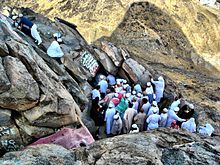Hira '
Hirā ( Arabic حراء, DMG Ḥirāʾ orحرا / Ḥirā ) is a mountain with a cave three Arab miles northeast of Mecca , which has an important meaning in Islam because it is here that the Prophet Mohammed received his first revelation according to Arabic tradition. The mountain is therefore also called Jabal an-Nūr ("Mountain of Light"). The event is associated with the beginning of Sura 96 . Ibn Hisham narrates that before the first revelation, Muhammad went for a month every year to retreat ( ǧiwār ) near Mount Hirā ', and explains that this was part of the tahannuth ( taḥannuṯ ) of the Quraysh .
The Tahannuth was a pious exercise that Mohammed's grandfather ʿAbd al-Muttalib ibn Hāschim is said to have introduced into Mecca. It was dedicated to the veneration of the holy precinct of Mecca, was carried out in the summer, and consisted of the giving of alms in addition to the retreat on Mount Hirā 'for several weeks. Other people in pre-Islamic Mecca who are said to have performed the Tahannuth were Chālid ibn al-Harith of the Kināna tribe , Hakīm ibn Hizām and the hemp Zaid ibn ʿAmr. Ibn Hishām even explicitly makes a connection between the practice and hempism by stating that taḥannuṯ is the same as taḥannuf (hempism) because the Arabs use the letterف / fāʾ like thāʾ /ث / ṯāʾ would pronounce. Kister suspects that the Islamic voluntary fasting in the months of Rajab and Shabān , which preceded the Islamic calendar reform in summer, originated in the Tahannuth ritual.
Those who did the Tahannuth chose different locations near Mount Hirā '. ʿĀ'ischa bint Abī Bakr chose a location between Mount Hirā 'and Mount Thabīr for a two-month retreat on one occasion. Mohammed himself is said to have withdrawn into a cave at the top of the Hirā 'before his first revelation. The following words are passed down from ʿĀ'ishah:
“Then he became fond of being alone, and he stayed in a cave on Mount Hirā 'to spend a number of nights in the Tahannuth before returning to his family. He used to get provisions for it. When this was used up, he returned to Khadidja to stock up on new supplies. "
The cave in which Mohammed is said to have stayed is still called the "Hirā'-Cave" (غار حراء / ġār al-ḥirāʾ ). According to the tradition of Ibn Hisham, Mohammed went to Mount Hirā 'again around 620 after his return from Ta'if to secure the necessary support from the inhabitants of Mecca.
literature
- TH Weir, W. Montgomery Watt: Art. "Ḥirāʾ" in Encyclopaedia of Islam , New Edition. Vol. III, p. 462.
- MJ Kister: "Al-Taḥannuth: an inquiry into the meaning of a term" in Bulletin of the School of Oriental and African Studies 31 (1968) 223-236.
- MJ Kister: "'Shaʿbān is my month'. A study of an early tradition." in J. Blau ao (ed.): Studia orientalia memoriae DH Baneth dedicata. Jerusalem 1979. pp. 15-37.
Web links
supporting documents
- ↑ See Kister: "Al-Taḥannuth: an inquiry into the meaning of a term". 1968, p. 232f.
- ↑ Cf. GR Hawting: Art. "Taḥannuth" in Encyclopaedia of Islam. New edition. Vol. X, pp. 98f. Here p. 98.
- ↑ See Kister: "Shaʿbān is my month." 1979, p. 34f.
- ↑ See Kister: "Shaʿbān is my month." 1979, p. 35.
- ↑ Quoting Kister: "Al-Taḥannuth: an inquiry into the meaning of a term". 1968, p. 224.
Coordinates: 21 ° 27 '27.2 " N , 39 ° 51' 33.9" E

